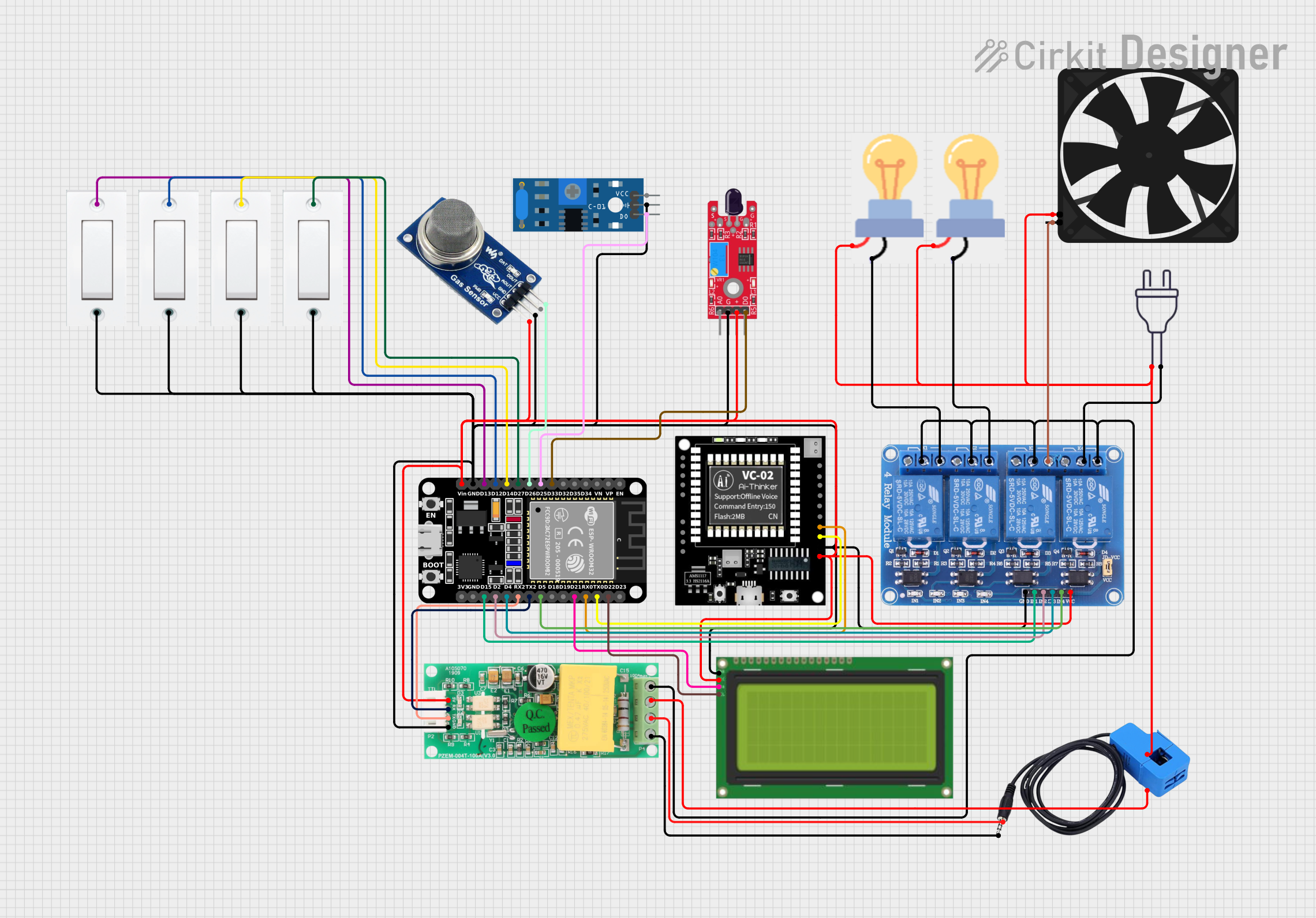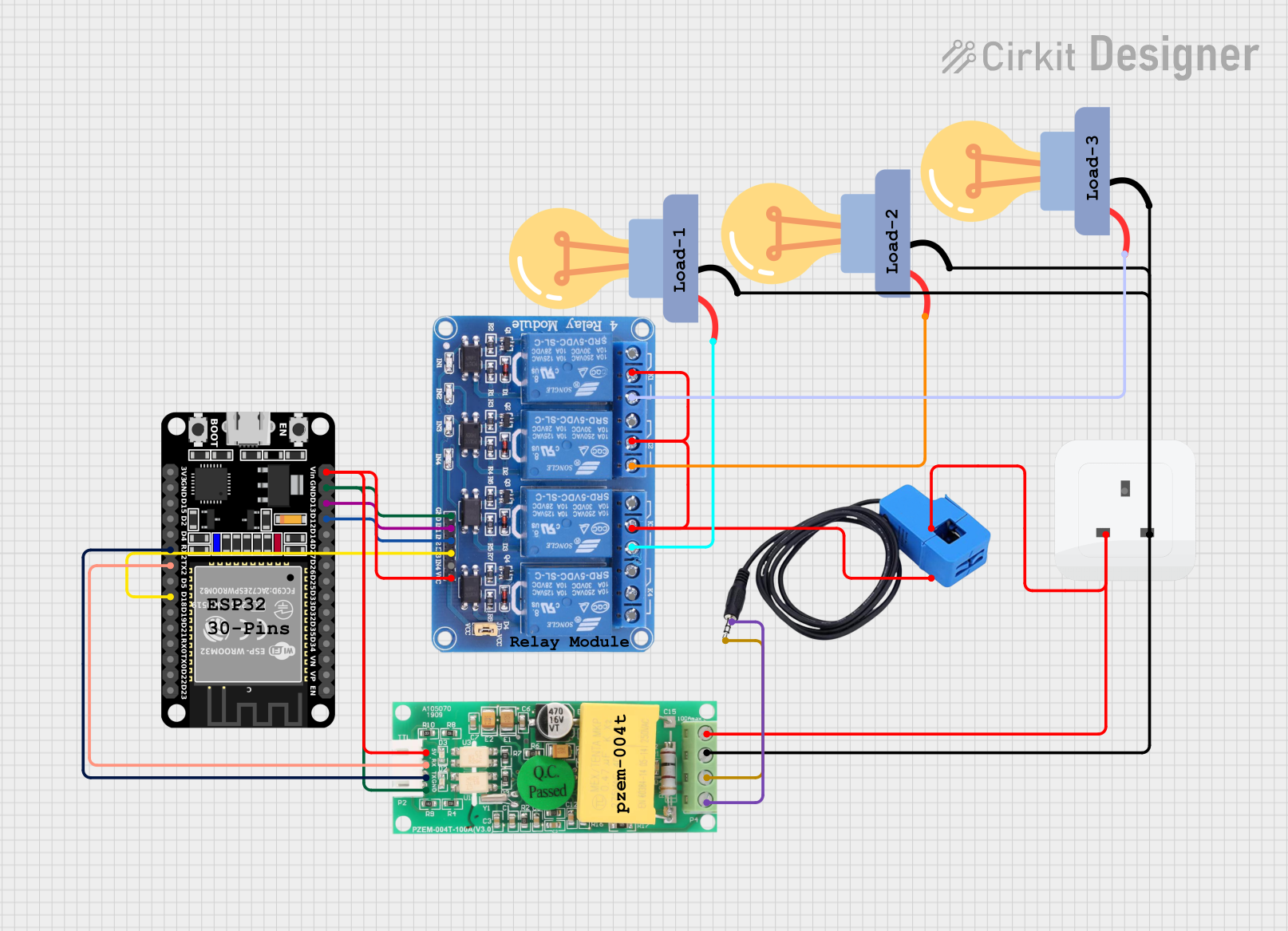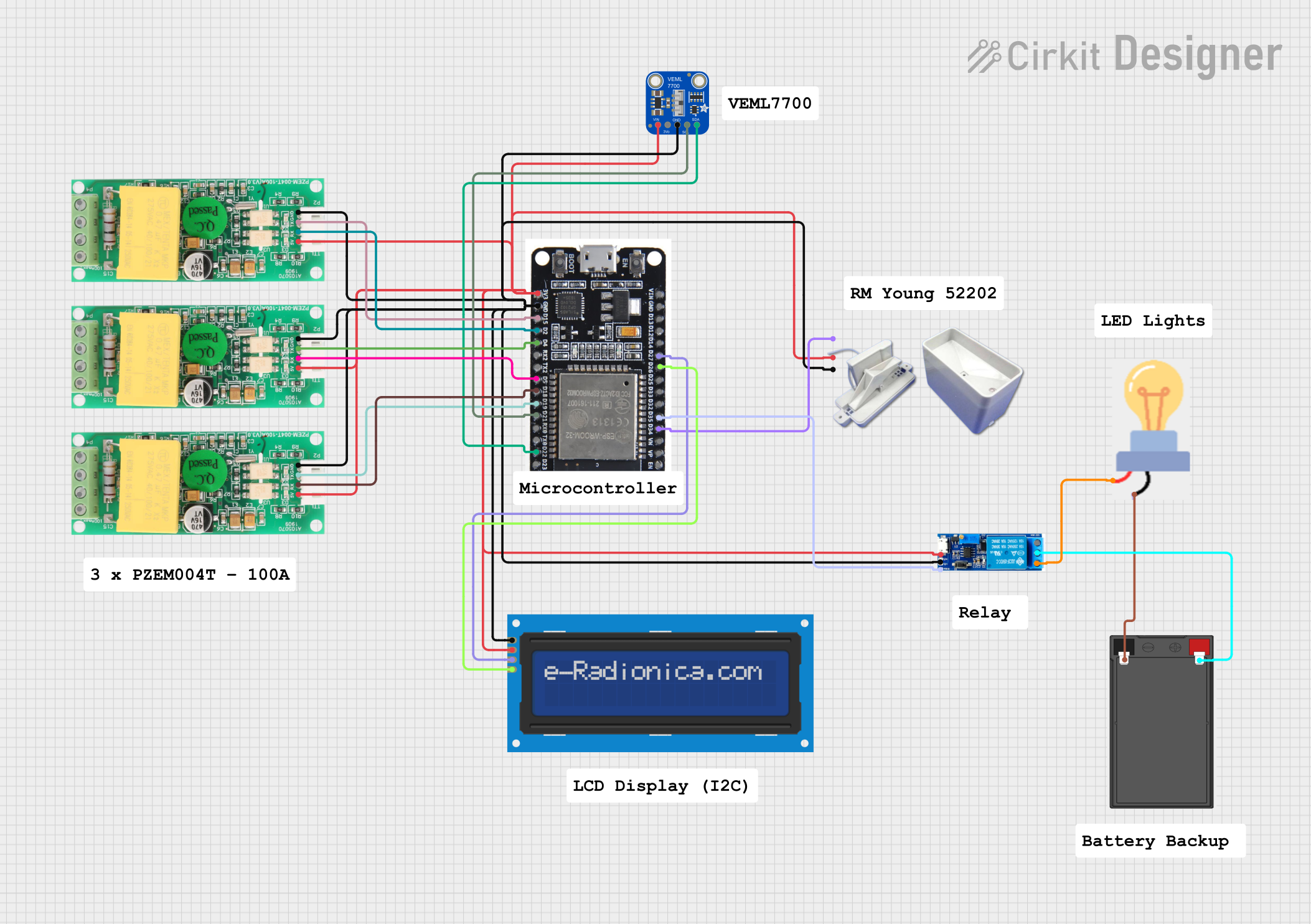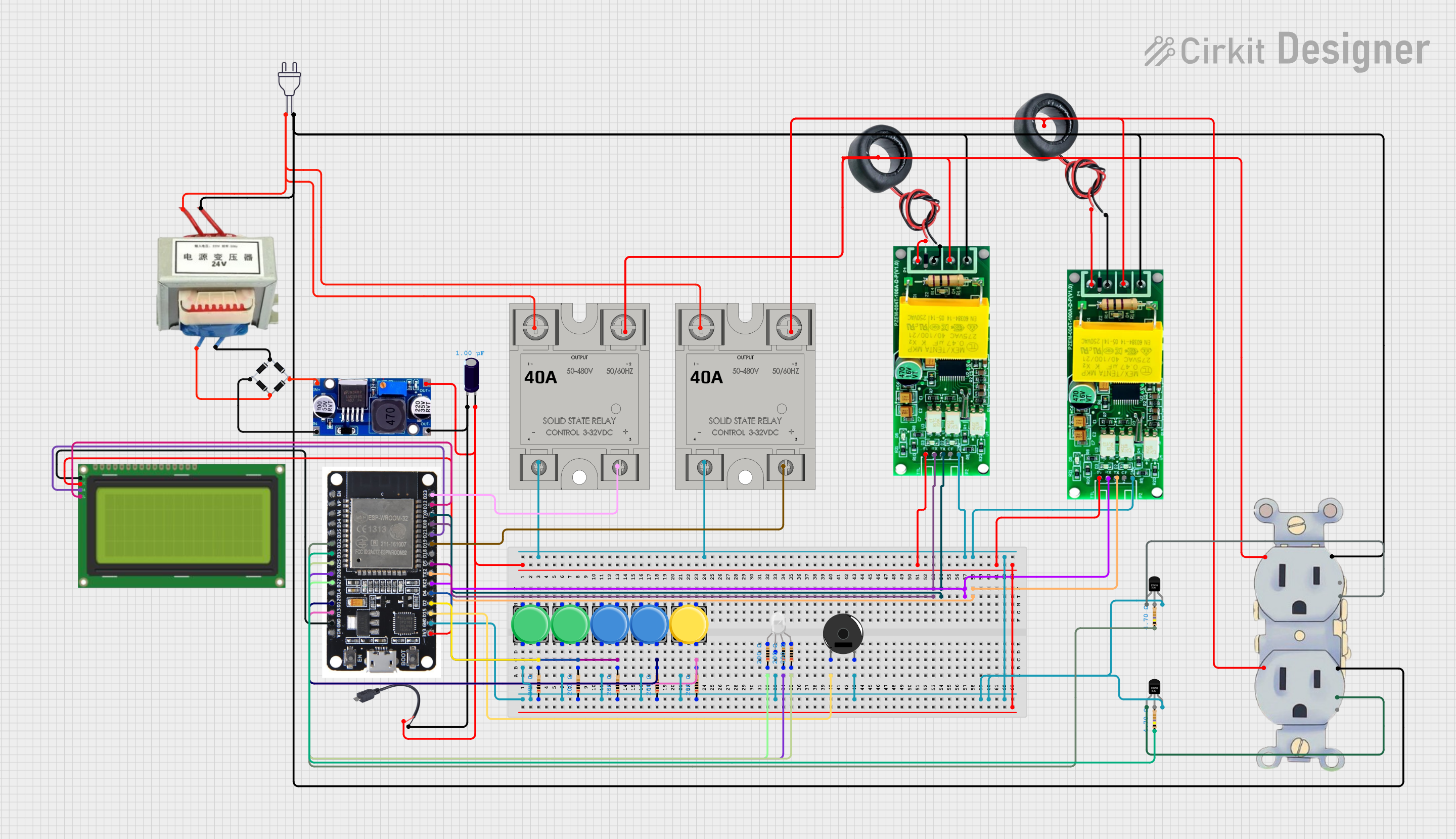
How to Use PZEM004t: Examples, Pinouts, and Specs

 Design with PZEM004t in Cirkit Designer
Design with PZEM004t in Cirkit DesignerIntroduction
The PZEM004t is a digital power meter designed for monitoring and measuring key electrical parameters in AC circuits. It provides real-time data on voltage, current, power, energy consumption, and frequency. This module is widely used in applications requiring precise energy monitoring, such as home automation, industrial equipment monitoring, and IoT-based energy management systems. Its built-in serial communication interface allows seamless integration with microcontrollers like Arduino, Raspberry Pi, and other embedded systems.
Explore Projects Built with PZEM004t

 Open Project in Cirkit Designer
Open Project in Cirkit Designer
 Open Project in Cirkit Designer
Open Project in Cirkit Designer
 Open Project in Cirkit Designer
Open Project in Cirkit Designer
 Open Project in Cirkit Designer
Open Project in Cirkit DesignerExplore Projects Built with PZEM004t

 Open Project in Cirkit Designer
Open Project in Cirkit Designer
 Open Project in Cirkit Designer
Open Project in Cirkit Designer
 Open Project in Cirkit Designer
Open Project in Cirkit Designer
 Open Project in Cirkit Designer
Open Project in Cirkit DesignerTechnical Specifications
The PZEM004t is a compact and efficient module with the following key specifications:
| Parameter | Value |
|---|---|
| Voltage Range | 80V - 260V AC |
| Current Range | 0A - 100A (with external current transformer) |
| Power Range | 0W - 22kW |
| Energy Range | 0kWh - 9999kWh |
| Frequency Range | 45Hz - 65Hz |
| Communication Interface | TTL Serial (3.3V/5V compatible) |
| Baud Rate | 9600 bps |
| Accuracy | ±0.5% |
| Operating Temperature | -10°C to 60°C |
| Dimensions | 70mm x 40mm x 20mm |
Pin Configuration and Descriptions
The PZEM004t module has a simple pinout for easy integration:
| Pin Name | Description |
|---|---|
| VCC | Power supply input (5V DC) |
| GND | Ground connection |
| TX | Transmit pin for serial communication (connects to RX of microcontroller) |
| RX | Receive pin for serial communication (connects to TX of microcontroller) |
| AC IN+ | Live wire input for AC voltage measurement |
| AC IN- | Neutral wire input for AC voltage measurement |
| CT+ | Positive terminal for the current transformer (CT) |
| CT- | Negative terminal for the current transformer (CT) |
Usage Instructions
How to Use the PZEM004t in a Circuit
- Power the Module: Connect the VCC pin to a 5V DC power source and the GND pin to ground.
- Connect the AC Input: Wire the AC IN+ and AC IN- terminals to the live and neutral wires of the AC circuit you want to monitor.
- Connect the Current Transformer (CT): Attach the CT+ and CT- terminals to the provided current transformer. Ensure the CT is clamped around the live wire of the AC circuit.
- Serial Communication: Connect the TX pin of the PZEM004t to the RX pin of your microcontroller and the RX pin of the PZEM004t to the TX pin of your microcontroller.
- Load the Code: Use the appropriate library and code to read data from the module.
Important Considerations and Best Practices
- Ensure all connections are secure and insulated to prevent electrical hazards.
- The module is designed for AC circuits only; do not use it with DC circuits.
- Use the provided current transformer for accurate current measurements.
- Avoid exceeding the specified voltage and current ranges to prevent damage to the module.
- If using with an Arduino, install the "PZEM004T" library from the Arduino Library Manager for simplified communication.
Example Code for Arduino UNO
Below is an example code to interface the PZEM004t with an Arduino UNO:
#include <PZEM004T.h> // Include the PZEM004T library
// Define the RX and TX pins for communication
#define RX_PIN 10
#define TX_PIN 11
// Create a PZEM004T object
PZEM004T pzem(RX_PIN, TX_PIN);
void setup() {
Serial.begin(9600); // Initialize serial communication for debugging
Serial.println("PZEM004t Power Meter Example");
}
void loop() {
// Read voltage
float voltage = pzem.voltage();
if (voltage < 0) {
Serial.println("Error reading voltage");
} else {
Serial.print("Voltage: ");
Serial.print(voltage);
Serial.println(" V");
}
// Read current
float current = pzem.current();
if (current < 0) {
Serial.println("Error reading current");
} else {
Serial.print("Current: ");
Serial.print(current);
Serial.println(" A");
}
// Read power
float power = pzem.power();
if (power < 0) {
Serial.println("Error reading power");
} else {
Serial.print("Power: ");
Serial.print(power);
Serial.println(" W");
}
// Read energy
float energy = pzem.energy();
if (energy < 0) {
Serial.println("Error reading energy");
} else {
Serial.print("Energy: ");
Serial.print(energy);
Serial.println(" kWh");
}
// Wait for 1 second before the next reading
delay(1000);
}
Troubleshooting and FAQs
Common Issues and Solutions
No Data Received from the Module:
- Ensure the TX and RX pins are correctly connected to the microcontroller.
- Verify the baud rate is set to 9600 bps in your code.
- Check the power supply to the module (5V DC).
Incorrect Readings:
- Ensure the current transformer is properly clamped around the live wire.
- Verify that the AC IN+ and AC IN- terminals are connected to the correct wires.
- Avoid using the module in circuits with high-frequency noise or unstable voltage.
Module Not Responding:
- Check for loose or incorrect wiring.
- Ensure the module is not exposed to temperatures beyond its operating range.
FAQs
Q1: Can the PZEM004t measure DC circuits?
No, the PZEM004t is designed specifically for AC circuits and cannot measure DC voltage or current.
Q2: Can I use the PZEM004t with a 3.3V microcontroller?
Yes, the PZEM004t's serial communication interface is compatible with both 3.3V and 5V logic levels.
Q3: How do I reset the energy reading to zero?
The energy reading can be reset using a specific command sent via the serial interface. Refer to the module's datasheet or library documentation for details.
Q4: What is the maximum distance between the module and the current transformer?
The current transformer should be placed as close as possible to the module to ensure accurate readings. Long distances may introduce noise and reduce accuracy.